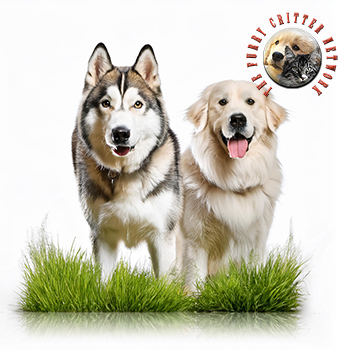Golden Retriever Breed Description - Cross #2
The Golden Retriever is a large, strongly-built breed with a dense water-repellant wavy coat. As a dog with origins in pedigree breeding, and due to its widespread historical popularity, some regional variations have emerged in the breed; therefore, there are three sub-types of the Golden Retriever that reflect the typical variations in dimensions and coat. However, all Golden Retrievers are blonde, yellow, or gold in color and all sub-types are susceptible to the same health problems.
British type Golden Retrievers are prevalent throughout Europe and Australia, and are distinguished from the North American lines by the official breed standards. The muzzle of the British dog is wider and shorter, and its forehead is blockier. Its legs are shorter, its chest is deeper, and its tail is slightly shorter. Due to these features, a British type usually weighs more than an American or Canadian. Males will be between 56 and 61 cm (22 and 24 in) at the withers; females will be slightly shorter, at between 51 and 56 cm (20 and 22 in). Acceptable or expected weights are not specified in the UK standard, but the KC standard calls for a level topline and straight hindquarters without the slight rear angulation found in American lines. The eyes of the European type are noted for their roundness and darkness, which is in contrast to the triangular or slanted composition of their American counterparts. A Golden Retriever of British breeding can have a coat color of any shade of gold or cream; red or mahogany are not permitted colors of coat. Originally, cream was an unacceptable color in the UK standard, but the standard was revised in 1936 to include cream. At the time of this revision, it was agreed the exclusion of cream as a color was a mistake, as the original "yellow" retrievers of the 19th century were actually lighter in color than was permitted by the standards that were used before 1936. As with American lines, white is an unacceptable color in the show ring. The British KC standard is used in all countries except the USA and Canada. Golden Retrievers have muscular bodies with great endurance, owing to their origins as hunting and gundogs.
American Golden Retrievers are taller than the British type, but retain its thick coat. The American Goldens are lankier and less stocky than British types. Males will stand between 23 and 24 in (58 and 61 cm) in height at the withers; females will be 21.5–22.5 in (55–57 cm). Their coat is dense and water-repellent, and comes in various shades of lustrous gold with moderate feathering. When trotting, they have a free, smooth, powerful, and well-coordinated gait; as the dog runs, its feet converge towards the centre of the line of balance. The American standard also makes requirements about the proportion, substance, head and skull, neck, body, topline, forequarters, and hindquarters; in these respects, the American type Retriever is the same as Golden Retrievers that conform to other national standards. American breeders of Golden Retrievers sometimes import their dogs from Britain, in order to take advantage of the temperment and appearance of the British types.
The Canadian Golden Retriever has a thinner coat and stands taller than other varieties of Golden Retriever. As with American Golden Retrievers, Canadians are often taller and leaner than their British counterparts. However, Canadian retrievers differ in the density and color of their coats, which are commonly thinner and darker than those of Americans.






